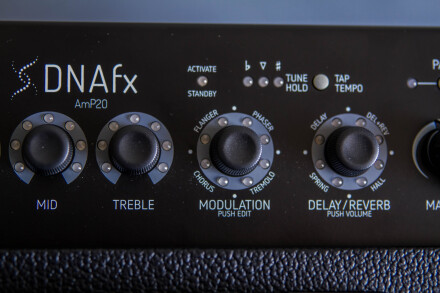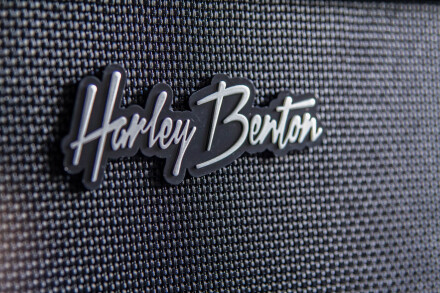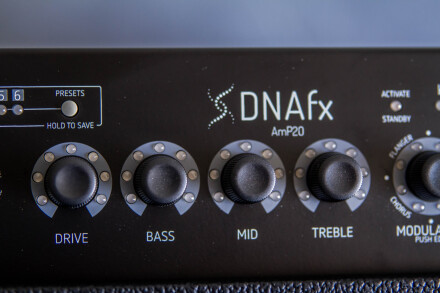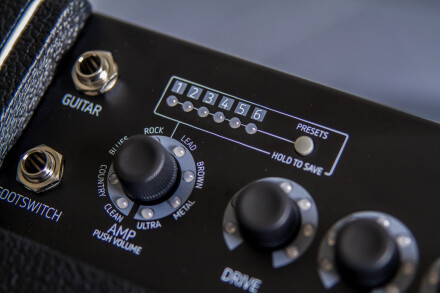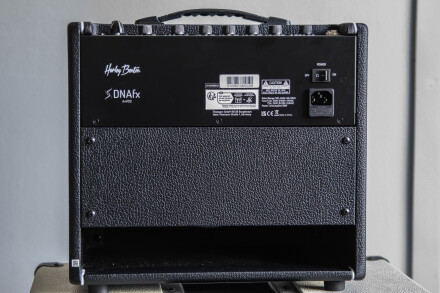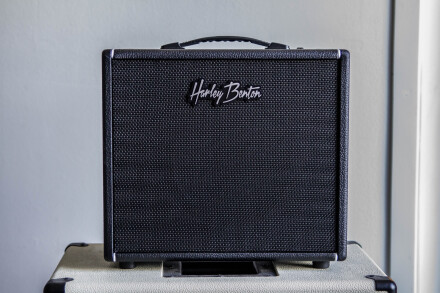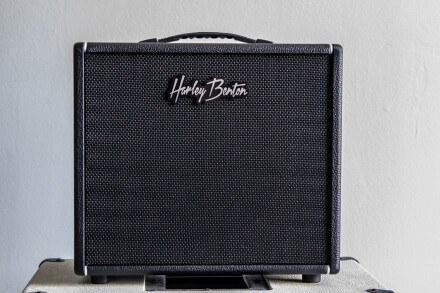DNAfx products from German manufacturer Harley Benton include multi-effects and amp modelers. Up until now, the manufacturer has released pedalboards and headphone amps in this line (the DNAfx GiT, GiT Pro, GiT Core, and GiT Mobile), but has now added a small 20-watt combo, the DNAfx AmP 20, as well.

Presentation and ergonomics of DNAfx AmP20
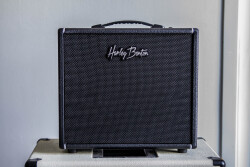
The amp is the first Harley Benton product to feature this type of speaker, commonly known as an "FR” (full-range) speaker. You can see this small speaker through the opening in the three-quarters-closed-back of the amp. The back panel houses the power plug (IEC C13 connector) and the ON/OFF button. The control panel, where the amp’s controls are located, is on the top of the combo, giving it a very uncluttered, almost elegant front panel. The top panel incorporates the following control knobs:
- Amp/Push Volume: lets you cycle through the eight different amp models (Clean, Country, Blues, Rock, Lead, Brown, Metal and Ultra) and adjust the volume when pressed
- Drive: adjusts saturation rate
- Bass, Mid and Treble: allow you to sculpt the sound
- Modulation/Push Edit: lets you browse modulation effects (Chorus, Flanger, Phaser and Tremolo) and access their edit menus by pressing them
- Delay/Reverb/Push Volume: enables you to browse the various ambient effects (Spring, Delay, Delay+Reverb and Hall)
- Master: adjusts overall listening volume
All these knobs are notched encoders encircled by red LEDs that are supposed to indicate their position. The 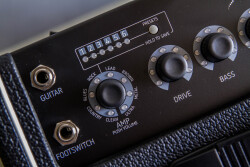
The Presets/Hold To Save button toggles between the amp’s six built-in presets and saves the sound you’re currently playing in one of six locations, indicated by green LEDs. Tap Tempo/Hold Tune, which is very practical, lets you tap the delay tempo and access the built-in tuner by pressing and holding it. The tuner has three LEDs, one green in the middle and one red on either side. It’s tedious to use and not very accurate. I prefer a good old-fashioned clip-on tuner, which is much easier to read and more efficient. Finally, the Pair button allows the user to pair a device via Bluetooth to send music or Backing Tracks to the amp. It’s a welcome feature that transforms this modest little amp into a real work too. Two mini-Jack 3.5 mm connectors, a stereo headphone output and a mono line input complete the control panel. After connecting my trusty Fender American Original '60s Telecaster to the DNAfx AmP 20, I began the test.
The eight models: from Clean to Brown, strengths and limitations
After powering up the DNAfx AmP 20, I ran through the eight amp models. Unsurprisingly, these were sounds with which I’m familiar, having already tested the DNAfx GiT and DNAfx GiT Advanced. In fact, Harley Benton has taken eight models from the list of fifty-five DNAfx virtual amplifiers and integrated them into this new combo. The Clean and Country sounds are quite successful and offer pleasant playing sensations. Having the Drive control is a real plus on all eight of these amp models, especially for achieving that famous “edge of breakup” sound I’m so fond of.
The three-band EQ is responsive enough to sculpt the sound, although a presence control would have been nice. The notched encoders are not so easy to use, as a notch doesn’t necessarily correspond to an LED. You have to get used to using them and adjust the sound not by following the dance of the red LEDs with your eyes but by listening to the sound. Most amp models, however, are well-realized and provide quite satisfactory sounds with the EQ untouched.

- Clean Spring01:05
- Country Hall00:56
- Blues Tremolo01:13
The Rock amp lives up to its name, providing a nice variety of sounds. The Drive control lets you range from light crunch to pretty thick saturation, which is nice. The Lead amp is a boosted version of the Rock amp, with a significant midrange bump to stand out from the mix during a solo, for example. The Brown sound was inspired by Eddie Van Halen. It’s this amp model that I prefer, offering, in my opinion, the most authentic playing experience along with the Clean and Country amps.
On the other hand, a Noise Gate is always active, which can be a pain. A small button to activate/deactivate or adjust the Noise Gate would have been a real plus. I’ll end my tour of the amps with the Metal and Ultra models. The Metal amp is nice and will be at home in less muscular genres such as Classic Rock or Oasis-style Brit-Pop. Finally, the Ultra amp is rather disappointing: it’s not all that “ultra." I was expecting a hyper-saturated sound, with a good “chug, " but was rather disappointed.

- Rock Hall01:35
- Lead Delay00:41
- Metal Drop D00:50
- Brown Gain Tweak02:15
Integrated effects: reverbs, delays and modulations – what works, what goes wrong
After exploring the various amps, I set out to discover the DSP effects built into the DNAfx AmP 20, starting with the ambient effects. The Spring reverb model is a disaster. The grain of the reverb is far too cartoonish, with a vast, unmusical “splash” tinting the sound with far too much treble. There are two variants per ambient effect, each with a different decay time. I’ll pass over the delay, which is a relatively simple digital delay, with a Tap Tempo button. You can’t adjust the number of repeats (feedback), which is a pity. The Delay+Reverb position mixes the digital delay with a Hall reverb, much more successful than its Spring cousin. Adjusting these effects is pretty straightforward. You select the effect you wish to use and press the encoder once to adjust its volume.

I continued the test by activating the chorus, which sounds authentic. Here too, each effect has two variants, with varying degrees of depth. You access the Edit function by pressing the Modulation encoder, but making the adjustments is laborious. The LEDs don’t seem to light up according to the settings you make with the encoder, and you’re not sure which parameter you’re tweaking. While the chorus is quite good, the flanger and phaser are not. The phaser, like the spring reverb, is very cartoonish. The tremolo is pleasant and brings a nice movement to the sound. Combined with the Hall reverb and the Country amp with the Drive on full, it provides a very musical sound.

Practical usage: Bluetooth, presets and jam at home
I ended the test by pairing the DNAfx AmP20 to my iPhone to send a backing track on it. Pairing the two devices was very quick and straightforward, and the sound the amp produced was satisfactory. To achieve the correct balance between the Backing Track and the guitar, you use the volume of the device paired to the amp, and the Volume control accessed by pressing the Amp knob., It’s in this “solo jam” context that the amp really comes into its own. It’s handy for working on songs on your own, or simply for perfecting your improvisation skills. It’s a shame, however, that a foot switch isn’t supplied with the amp (the Harley Benton FSL-1, the footswitch designed to work with the amp, is priced at €14.90/$14.40), and would have been quite welcome to switch from one preset to another without having to touch the amp.


